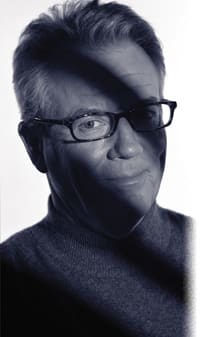Going
Gray
Lenses for Seniors
By Joseph L. Bruneni
Photography by Peter Baker
Between aging baby boomers and the longer life span of the U.S. population in general, we are now experiencing what has been termed the "graying of America." This demographic population surge is sometimes compared to a python swallowing a pig. The bulge of the pig gradually passes from one end of the python to the other. The aging of the general population is producing a profound effect on the eyecare professions, but the results of this are not always acknowledged in the dispensary.
|
|
|
|
The aging of the population means a bright future for
eyecare. |
|
There are currently 58.7 million people aged 55 or over in the U.S., and those numbers will rise to 63.2 million next year, proof indeed that the bulge of the pig is passing throughout the length of the python. Americans aged 55 and older now comprise 21 percent of the entire U.S. population and represent 29 percent of all adults age 18 and over. One of the most interesting statistics applying to this group is that they also control almost half of all after-tax income.
Here we examine how the needs of these older eyeglass wearers differ from the general population and explain how recognizing those differences can help dispensers better provide for the visual well-being of older patients. We will also explore the substantial marketing advantages to be gained in catering to the needs of seniors.
Why should caring for the visual needs of a 60-year-old patient be different from that of a 40-year-old? Much of the difference lies in the mind of the patient. As people age, they often fail to recognize how time has affected their bodies--in particular, how it affects their eyes.
This requires a patient explanation by the dispenser on how eyes and the body change in the aging process. Dispensers should explain that they understand what is happening to the patient's visual system and are prepared to recommend ways to help cope with these natural changes. "Natural" is a good word to use when discussing these changes.
Seniors are more comfortable when they understand that you will be able to suggest the best lenses to cope with their special needs, which are often taken for granted. There's no better way to earn their loyalty and they often then bring other members of their family for that same kind of personal eyecare.
|
|
|
|
Today's seniors are more active than previous generations, and they expect eyewear that can keep up with their lifestyles while looking great. LeMan style 8890 for Cottet Morel |
LIVING WELL, SEEING WELL
The use of lifestyle questionnaires has become routine in many offices, and this form has become an indispensable tool in caring for the needs of seniors. As you learn more about the mindset of older folks, you'll discover that their lifestyle is seldom what might be expected for their age. People are living longer and are continuing with active lifestyles far longer than was customary in the past. Many of those activities are visually intensive and should be reviewed by the eyecare provider.
Some seniors start new careers or go back to school, and many become involved in volunteer work that can be as demanding as a paid job. The lifestyle questionnaire should ask about each of these activities and should also ask for details about sports and hobby activities. The best questionnaires will provide room for the patient to rank the importance of activities from "not important" to "very important."
CREATING COMFORT
Weight is usually the most important consideration in choosing which frame and lens materials to recommend to older patients. As people age, the fatty tissue between skin and the nose thins out so there is less cushioning for glasses. Both polycarbonate and Trivex are lightweight lens materials, and both can be surfaced thinner than normal to 1.0mm centers, further reducing weight.
Keep frame sizes as small as possible to further limit the weight of the final eyeglasses. In selecting frames, guide them toward choosing frames that have a PD close to theirs. This reduces the need for decentration and adds to weight reduction.
Considerations include the following:
Tints and coatings: Some older patients will ask for a tint in their lenses to help when driving at night. This is not a good idea because older eyes need more light at night, not less. The best recommendation is an anti-reflective coating. It solves the difficulties of night driving far better than a tint and actually increases the amount of light entering their eyes.
In regard to photochromic lenses, earlier versions of these changeable lenses were not always recommended for seniors because the lenses never completely cleared. There was always a slight reduction of light transmission when the lenses were indoors or worn at night. This presents a potential problem for older eyes after dark.
Fortunately, there have been substantial improvements in the photochromic technology, and the newest lenses are virtually clear indoors and at night. This makes them a very appropriate choice for seniors, and the practicality of a pair of glasses that work for both indoors and outdoors also appeals to them.
|
|
|
|
Technology is embraced by seniors, from the Internet to PALs. a/p lab style 7001 for Mitani USA |
|
Don't overlook conventional prescription sunwear as another option. Bright sunlight is just as harsh and annoying for them as it is for younger people. It's unfortunate that so many people wait until their golden years to enjoy the comfort and convenience of prescription sunglasses.
In regard to sunwear, many seniors consider clip-on sunglasses to be the perfect accessory for eyewear. They are certainly convenient, but double the weight of eyewear and are not the best option for older wearers. Explain the disadvantages of the added weight and recommend photochromic lenses or prescription sunglasses as more sensible options for older people.
Progressives: The use of progressive addition lenses has increased substantially in recent years, and PALs are now the lens-of-choice in most offices for beginning presbyopes. Some dispensers tend to shy away from suggesting progressives to older patients who come in wearing bifocals or trifocals.
Though they apparently consider converting long-time bifocal/trifocal wearers to progressives to be like trying to teach a new trick to an old dog, that attitude is simply out-of-date. There's no such thing as too old a person to convert to PALs.
If the advantages of progressives are explained properly to older people who avoided them in the past, many will accept this new technology as another challenge to be met and conquered.
There's an old saying that claims "growing old isn't for sissies." No one knows that better than someone in his or her 60s, and most of these people have learned to meet their problems head-on. They had to learn how to wear bifocals or trifocals, and we now know that learning to wear PALs is no more difficult. It's unlikely that any senior who converts to PALs will ever regret the decision. Progressives offer too many advantages.
Regarding fashion: Don't assume that older folks become less interested in how they look. Creating a new look can be an important event in an older person's life. Good looking new eyeglasses fit right into that scenario.
CONSIDERING COMPUTERS
We tend to think of computers in connection with young people, but adults 55 and older are the fastest-increasing number of online users (30 percent and growing). Seniors are also second only to families as the largest group of first-time computer purchasers.
In general, seniors average more time on their computers than any other age group. A recent survey showed they averaged 12 hours per week, compared to 9 hours for male adults and college students. Approximately one-third of male seniors ages 65 to 74 own a computer and among those 75 and older, the figure runs about 23 percent.
What this tells us is that the use of computers should always be explored with older patients. No other activity is as visually intensive as working or playing in front of a computer. This is true for patients of any age, but using a computer imposes even greater visual demands when the user is a senior citizen. If your lifestyle questionnaire doesn't specifically ask about computer use, make sure this important subject is discussed during the dispensing process.
Once you have determined that the patient is involved with the use of a computer, you need to explain that computers present special visual demands, particularly for those who wear multifocals or progressives.
Tell them how viewing a monitor differs from traditional reading since the viewer is looking at illuminated pixels of light instead of the sharp contrast of black ink on white paper. In addition, the position and distance to a typical monitor falls beyond the capabilities of conventional bifocals, trifocals, or progressives.
Then explain how a special type of lens called "variable focus" has been developed specifically to help computer users cope with this problem. These lenses are available from a variety of manufacturers, and some of these companies have produced effective brochures that explain and diagram how variable focus lenses do their work.
|
|
|
|
Fashion isn't forgotten once people hit retirement age. In fact, glasses can become a major accessory for this group. Kio Yamato style KP-022 for Kio Yamato Optix |
VARIETY FOR EFFICIENCY
One of the most important points that older patients need to understand is that for maximum benefit and efficiency, one pair of glasses will seldom serve all of their visual needs. This is particularly true for computer users. They need to resign themselves to the realization that comfortable viewing of computer monitors requires eyewear dedicated specifically for that purpose.
The concept of glasses for specific uses goes beyond computer users, however. For example, every presbyope should be offered a special pair of reading glasses, instead of just everyday bifocals, trifocals, or progressives.
Their normal reading correction in single vision lenses can work well for reading glasses, but the new variable focus lenses can be an even better choice. They are also less expensive than conventional progressives and are a good choice for most indoor work or play--including a variety of hobbies as well. They provide an exceptionally wide field of vision for near and intermediate and offer reasonably good vision for walking inside an office or a home.
Suggest dedicated reading glasses for older patients who are involved with:
- Any kind of concentrated near tasks (from hobbies to cooking to reading)
- Prolonged reading of any kind (whether lying down or sitting up)
- Any kind of computer use
- Any indoor activity
CATERING TO THEMSELVES
Older patients are more willing to invest in things that can bring increased comfort or, just as important, improved convenience. This is why older people are more apt to spend extra for a second or third pair of glasses.
Most seniors are increasingly involved with managed care and often express growing concern over various aspects of healthcare. They are often subjected to the uncomfortable feeling of being a single cipher in a vast sea of indifferent healthcare providers. This feeling has become part of the aging process, so exceptional personal service stands out like a beacon from the mediocre service found so often with other healthcare providers.
When you are able to demonstrate care, concern, and knowledge regarding the special visual needs of your older patients, they will become loyal customers and, more often than not, will bring in the rest of their family.







